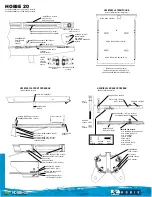
PRECAUTIONARY NOTES:
Make sure you are familiar with how to deal with the following
situations, which can occur in open water.
Consult local experts or available literature for additional
information on these important subjects.
A.WEATHER
1.Wind
Avoid paddling when whitecaps are visible until you thoroughly
appreciate their effect. Wind can 1) upset a kayak, 2) make
it difficult to turn, 3) create unmanageable waves, 4) prevent
you from holding a course, and 5) slow you down or stop you.
2.Fog
Fog can result in sudden and total disorientation. You will need
a compass, but you may gain some orientation from sounds of
beach surf, bells, foghorns, etc., as well as from steady wave
and wind direction. Boat traffic can become a major hazard.
B.CURRENT
You will encounter two principal types of current on the sea:
reversing tidal current and continuous ocean current.
Strong current can aggravate conditions caused by adverse
weather, particularly when current and wind are opposing. They
can also cause difficult eddy and wave conditions even on utterly
still days, from the sheer force to the flow.
Precautions:
1. Read your chart to help identify danger points.
2. Use any available information to estimate slack or
favorable current and time your passage or crossing
for that period.
3. Paddle in current under controlled conditions to familiarize
yourself with its effect.
4. Exercise caution when the current and wind direction
oppose each other.
C.TOPOGRAPHY
Topography affects wind and water conditions in shallows, beach
surf, headlands, cliffs and river mouths.
Shallows:
Waves steepen and break heavily on shallows.
Avoid those areas when waves are large or strong currents are
forced to flow over them.
Surf:
Waves steepen and break on beaches and shoals.
Generally, try to avoid landing in surf with a loaded kayak. Avoid
surf on rocky beaches.
Headlands:
Conditions are frequently more difficult off headlands
with increased wind (funneling), accelerated current and rebound
waves. Seas become chaotic.
Cliffs:
Cliffs limit landing sites and can cause chaotic rebound
wave conditions.
River mouths:
Difficult wave conditions occur when a river
outflow runs against the waves.
PEOPLE HAZARDS
Watch for powerboats, ships, tugboats with barges and all other
watercraft. Make yourself visible and never assume you have
been or have the right of way.
LAKE PADDLING
With the exception of the tides, large lakes pose most of the
difficulties and dangers of the sea.
Waves, however, are steeper and more likely to break than on
the sea.
...FINALLY
The basis of safe sea kayaking is sound judgment, self-
responsibility and technical competence.
Join a club, take a class, read books and/or consult local experts
to learn all you need to know about the sport. Remember that
where you paddle, others will follow. Leave your campsite as
you would like to find it.
Содержание Carbolite 2000
Страница 1: ......



































